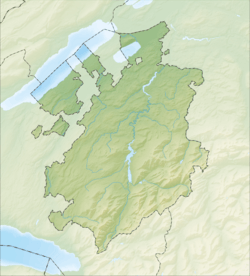Massonnens facts for kids
Quick facts for kids
Massonnens
|
||
|---|---|---|
 |
||
|
||
| Country | Switzerland | |
| Canton | Fribourg | |
| District | Glâne | |
| Area | ||
| • Total | 4.29 km2 (1.66 sq mi) | |
| Elevation | 733 m (2,405 ft) | |
| Population
(Dec 2020 )
|
||
| • Total | 548 | |
| • Density | 127.74/km2 (330.8/sq mi) | |
| Postal code |
1692
|
|
| Surrounded by | Grangettes, Le Châtelard, Mézières, Villaz-Saint-Pierre, Villorsonnens, Vuisternens-devant-Romont | |
Massonnens is a small town, also called a municipality, located in the canton of Fribourg in Switzerland. It's part of the Glâne district. The town's name is pronounced "masɔnɑ̃s" in French.
Contents
History of Massonnens
Massonnens was first mentioned a very long time ago, around the years 929-930. Back then, it was known by names like Mansaningis or Massaningis.
Geography and Landscape
Massonnens covers an area of about 4.3 square kilometers (1.7 square miles). Most of this land, about 73%, is used for farming. Forests cover about 21% of the area. The remaining 6% is where buildings and roads are located.
The town is built on a flat area above the Neirigue river. Massonnens includes the main village and a smaller settlement called Ferlens.
Massonnens Coat of Arms
A coat of arms is a special design that represents a family, town, or country. The coat of arms for Massonnens has a red background. It features a golden band with silver edges. Below this, there is a golden cross with rounded ends, also on a red background.
Population and People
Massonnens has a population of about 548 people. In recent years, the population has grown slightly. Most people in Massonnens speak French as their main language. A smaller number speak German or Portuguese.
In 2008, about half of the population was male and half was female. Most residents were born in Massonnens or in the same canton of Fribourg.
Age Groups in Massonnens
In 2000, about 13% of the population were children aged 0-9. Teenagers (10-19 years old) made up about 21%. Adults between 20 and 59 years old made up a large part of the population. Older adults, aged 60 and above, made up about 15% of the population.
Homes and Households
In 2000, there were 128 private homes in Massonnens. On average, about 3 people lived in each home. Most apartments were lived in all the time. A small number were used for holidays or were empty.
Historical Population Growth
The chart below shows how the population of Massonnens has changed over many years.

Important Heritage Sites
The Saint-Maurice Church in Massonnens is a very important building. It is listed as a Swiss heritage site of national significance. This means it is a special place that is protected because of its history and cultural value.
Economy and Jobs
In 2010, the unemployment rate in Massonnens was low, at 3%. This means most people who wanted to work had jobs.
Types of Jobs
Jobs in Massonnens are divided into three main types:
- Primary sector: These jobs involve getting raw materials, like farming. Many people in Massonnens work in agriculture.
- Secondary sector: These jobs involve making things, like in factories or construction.
- Tertiary sector: These jobs involve providing services, like shops, restaurants, or education.
In 2008, there were 65 full-time jobs in Massonnens. Most of these were in farming. Other jobs included manufacturing, construction, sales, transport, and education.
Commuting to Work
Many people who live in Massonnens travel to other towns for work. In 2000, about 119 people left Massonnens for work, while only 11 came into the town to work. Most people used a private car to get to their jobs.
Religion in Massonnens
In 2000, most people in Massonnens, about 88%, were Roman Catholic. A smaller number belonged to the Swiss Reformed Church or other Christian churches. Some people did not belong to any church.
Education System
In Massonnens, about 31% of the population has finished upper secondary education. This is like high school. About 6% have gone on to higher education, like a university or a specialized college.
School System in Fribourg
The school system in the Canton of Fribourg works like this:
- One year of optional Kindergarten.
- Six years of Primary school.
- Three years of required lower Secondary school. Students are grouped by their abilities.
- After lower Secondary, students can choose to go to a three or four-year upper Secondary school. This can be a gymnasium (which prepares students for university) or a vocational program (which teaches job skills).
- After upper Secondary, students can go to a higher education school or start an apprenticeship.
Students in Massonnens
During the 2010-2011 school year, 32 students attended classes in Massonnens. There was one kindergarten class and one primary class. Students for lower secondary, upper secondary, and higher education usually went to schools in nearby towns.
See also
 In Spanish: Massonnens para niños
In Spanish: Massonnens para niños





